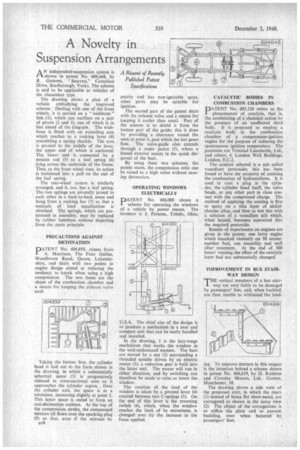A Novelty in Suspension Arrangements
Page 52

If you've noticed an error in this article please click here to report it so we can fix it.
A Resume' of Recently Published Patent Specifications A N independent-suspension system is shown in patent No. 604,648, by R. Greaves, Seacrest," Cornelian Drive, Scarborough, Yorks. The scheme is said to be applicable to vehicles of the chassisless type.
The drawing shows a plan of a vehicle embodying the improved scheme. Dealing with one of the front wheels, it is carried on a " wishbone " link-(1), which can oscillate on a pair of pivots (2 and 3), one of which is in line ahead of the king-pin. The wishbone is fitted with an extending arm which reaches to a rocking lever (4) resembling a spring shackle. The arm is pivoted to the middle of the lever. the upper end of which is anchored. The lower end is connected by a tension rod (5) to a leaf spring (6) lying across the underside of the frame. Thus, as the front wheel rises, its action is translated into a pull on the end of the leaf spring.
The rear-wheel system is. similarly arranged, and it, too, has a leaf spring. The two springs are pivotally joined to each other in a back-to-back sense and hung from a rocking bar (7) so that a measure of load equalization ' is obtained. The springs, which are prestressed in assembly, may be replaced by rubber Members without departing from the main principle
PATENT No. 604,850, comes from A. Morrison, The Four Gables, Woodhouse Road, Quorn, Leicestershire, and deals with two points in engine design aimed at reducing the tendency to knock when using a high compression. The two items are the shape of the combustion chamber and a means for keeping the exhaust valve cool.
• Taking the former first, the cylinder head is laid out to the form shown in the drawing, in which a substantially spherical space (1) is progressively reduced in cross-sectional area as it approaches the cylinder region.. Over the cylinder axis, the space is at a minimum, increasing slightly at point 2. This latter space is stated to form an anti-detonation cushion. At the top of the compression stroke, the compressed mixture all flows over the sparking plug (3) so that, even if the mixture be n1R patchy and has non-ignitable spots, other parts may be suitable for ignition.
The second part of the patent deals with the exhaust valve and a means for • keeping it cooler than usual. Part of the scheme is to shield it from the hottest part of the guide; this is done by providing a clearance round the stem at point 4, past which the hot gases flow. The valve-guide also extends through a water jacket (5), where a finned exterior assists in the quick dispersal of the heat.
By using these two schemes, the patent states, the compression ratio can be raised to a high value without causing detonation.
PATENT No. 604,000 shows a scheme for operating the windows of a vehicle by power means. The inventor is J. Parsons, Toledo, Ohio,
U.S.A. The chief aim of the design is to produce a mechanism in a neat and compact unit that can be easily handled and installed.
In the drawing, 1 is the lazy-tongs mechanism that works the window in the well-understood manner. The bars are moved by a nut (2) surrounding a threaded spindle driven by an electric motor (3); a reduction gear is built into the latter unit. The motor will run in either direction, and by switching can therefore be made to raise or lower the window.
The reaction of the load of the window is taken by a pivoted lever (4) centred between two C-springs (5). On the end of this lever is the reversing switch (6), which, when the window reaches the limit of its movement, is changed over -by the increase in the force applied.
PATENT No. 603,120 refers to the phenomenon of catalysis, that is, the accelerating of a chemical action by the presence of an unaffected third body. It is proposed to employ a catalytic body in the combustion chamber of a compression-ignition engine for the purpose of reducing the spontaneous ignition temperature. The patentees are Trinidad Leaseholds, Ltd., and others, 4, London Wall Buildings, London, E.C.2.
The catalyst selected is a salt called vanadium pentoxide; this has been found to have the property of assisting the combustion of hydrocarbons. It is used to coat a plug in the cylinder, the cylinder head itself, the valve heads, or any other part in close contact with the compressed charge. The method of applying the coating is first to spray on a thin layer of nickelchrome alloy, and then to wet this with a solution of a vanadium salt which, when heated, becomes converted into the required pentoxide.
Results of experiments on engines are given in the patent; one lorry engine which knocked violently on 30 cetanenumber fuel, ran smoothly and well after treatment. At the end of 300 hours' running the effect of the catalytic layer had not substantially changed.
IMPROVEMENT IN BUS STAIRWAY DESIGN
THE vertical members of a bus stair' way are very liable to be damaged by passengers' feet, and, when buckled, are then unable to withstand the load ing. To improve matters in this respect is the intention behind a scheme shown in patent No. 604,619, by D. Rushton and Crossley Motors, Ltd.. Gorton, Manchester, 18.
The drawing shows a side view of the proposed stair, in which the risers (I) instead of being flat sheet-metal, are corrugated as shown in the scrap view (2). The object of the corrugations is to stiffen the plate and so prevent buckling, even when battered by passengers' feet.




























































































